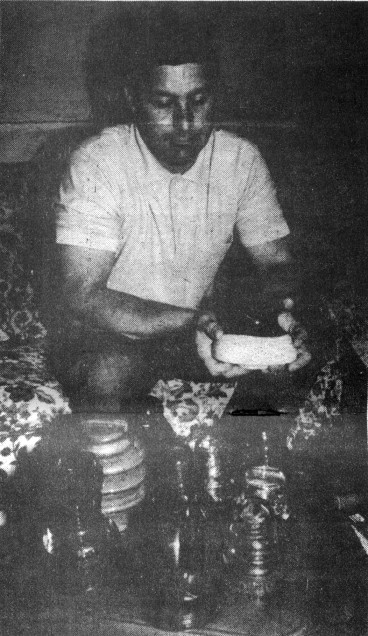Insulator Collector of the Month
by Robin Young Roe
Reprinted from "INSULATORS - Crown Jewels of the Wire", June 1980, page 24
Insulators, All Shapes, Colors for One Collector
What strikes
Art Kottman of Bayport as a bit peculiar is that not more of his fellow workers
have taken up his hobby: collecting insulators.
Oddly enough, it took the
lineman 13 years himself to take notice of the rainbow assortment of glass and
porcelain fixtures that are used to protect electrical wires from weather. He
bought the first one of a collection that today numbers in the hundreds at a
flea market in Labanon, N.Y. The polished, glistening amber colored insulator
sits in a prominent place on the family mantelpiece.
"It just caught my
fancy," he said recently, as he caressed a smaller, aqua insulator in his
large hands, running his fingers over the smooth surface.
What started out as a
whimsical weekend purchase, however, has grown into a collection of veritable
antiques that line the shelves of his living room and flows over into boxes and
wooden crates in the cellar.
Mr. Kottman, whose collection is featured in the
Time-Life, Inc. Encyclopedia of Collectibles, has traveled all over the country
to scour flea markets and fairs for insulators.
Insulators became popular
collectors items when old electric cable lines started to come down after World
War II as suburban areas grew.

Collector Arthur Kottman of Bayport with some of his insulators.
Large Image (229 Kb)
Color was well as age, Mr. Kottman said,
determines its value. Cobalt blue are the most difficult to find. Clear glass
insulators are most common; Purple, green, blue and aqua fall somewhere in
between.
When insulators were first manufactured, color was more a factor of
economy than design. Mr. Kottman said, "Bottle companies were making
insulators at the end of the day when all the important work was done. Everyone
figured electricity was a passing fancy. Whatever glass they had left over
they'd mix together to make insulators."
Later, when the telegraph gave way
to the telephone, manufacturers took a more serious look at the color and shapes
of the insulators. Over the years, different colors have been tried as possible
deterrents to insects and birds that might build nests on the utility line cross
bars. The newer insulators are made of porcelain, some of them with a dark brown
cap and a light gray bottom. Why? Apparently, Mr. Kottman said to please
conservationists with the earthy tones.
For collectors, like Kottman, the
variety is part of what makes this particular object challenging.
One simple
rule for dating insulators, is that threaded ones were made in 1869 or later
after Frenchman Louis Cauvet invented a wood pin to hold the fixtures an the
crossbars.
Ones that look like Roman centurion headgear, with a groove on top
for cable wires are a favorite of Kottman's. He jokingly refers to them as
Mickey Mouse insulators.
What seems a complicated classification system to the
uninitiated, is, actually, Kottman claims, "really pretty simple." If
you're looking for a real challenge, he laughs, "collect bottles. Now
there's something that is really hard,"
| 